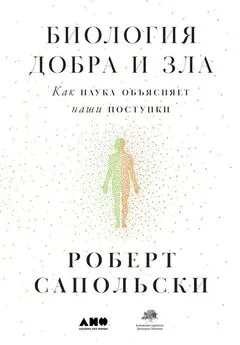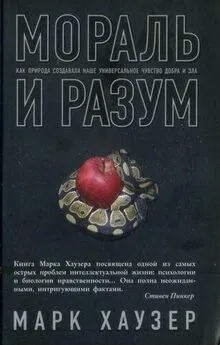Роберт Сапольски - Биология добра и зла. Как наука объясняет наши поступки
- Название:Биология добра и зла. Как наука объясняет наши поступки
- Автор:
- Жанр:
- Издательство:Альпина нон-фикшн
- Год:2019
- Город:Москва
- ISBN:978-5-0013-9051-0
- Рейтинг:
- Избранное:Добавить в избранное
-
Отзывы:
-
Ваша оценка:
Роберт Сапольски - Биология добра и зла. Как наука объясняет наши поступки краткое содержание
Биология добра и зла. Как наука объясняет наши поступки - читать онлайн бесплатно ознакомительный отрывок
Интервал:
Закладка:
857
D. Freedberg and V. Gallese, “Motion, Emotion and Empathy in Esthetic Experience,” TICS 11 (2007): 197; S. Preston and F. de Waal, “Empathy: Its Ultimate and Proximate Bases,” BBS 25 (2002); 1; J. Decety and P. Jackson, “The Functional Architecture of Human Empathy,” Behav and Cog Nsci Rev 3 (2004): 71.
858
J. Pfeifer et al., “Mirroring Others’ Emotions Relates to Empathy and Interpersonal Competence in Children,” NeuroImage 39 (2008): 2076; V. Gallese, “The ‘Shared Manifold’ Hypothesis: From Mirror Neurons to Empathy,” J Consciousness Studies 8 (2001): 33.
859
J. Kaplan and M. Iacoboni, “Getting a Grip on Other Minds: Mirror Neurons, Intention Understanding, and Cognitive Empathy,” Soc Nsci 1 (2006): 175.
860
Центр создания культуры эмпатии, “Mirror Neurons,” http://cultureofempathy.com/, no date, http://cultureofempathy.com/References/Mirror-Neurons.htm; J. Marsh, “Do Mirror Neurons Give Us Empathy?” Greater Good Newsletter , March 29, 2012; V. Ramachandran, “Mirror Neurons and Imitation Learning as the Driving Force Behind ‘the Great Leap Forward’ in Human Evolution,” Edge , May 31, 2000.
861
Grayling цит. по C. Jarrett, “Mirror Neurons: The Most Hyped Concept in Neuroscience?” Psychology Today , December 10, 2012, www.psychologytoday.com/blog/brain-myths/201212/mirror-neurons-the-most-hyped-concept-in-neuroscience; C. Buckley, “Why Our Hero Leapt onto the Tracks and We Might Not,” New York Times , January 7, 2007.
862
Все цитаты по: Hickok, 2014, op cit. Дополнительный анализ скептицизма см: C. Jarrett, “A Calm Look at the Most Hyped Concept in Neuroscience: Mirror Neurons,” Wired , December 13, 2013; D. Dobbs, “Mirror Neurons: Rock Stars or Backup Singers?” News Blog , ScientificAmerican.com, December 18, 2007; B. Thomas, “What’s So Special About Mirror Neurons?” Guest Blog , ScientificAmerican.com, November 6, 2012; A. Gopnik, “Cells That Read Minds?” Slate , April 26, 2007; and “A Mirror to the World,” Economist , May 12, 2005, www.economist.com/node/3960516.
863
L. Jamison, “Forum: Against Empathy,” Boston Review , September 10, 2014.
864
C. Lamm et al., “The Neural Substrate of Human Empathy: Effects of Perspective-Taking and Cognitive Appraisal,” J Cog Nsci 19 (2007): 42.
865
N. Eisenberg et al., “The Relations of Emotionality and Regulation to Dispositional and Situational Empathy-Related Responding,” JPSP 66 (1994): 776; G. Carlo et al., “The Altruistic Personality: In What Contexts Is It Apparent?” JPSP 61 (1991): 450.
866
B. Briers et al., “Hungry for Money: The Desire for Caloric Resources Increases the Desire for Financial Resources and Vice Versa?” Psych Sci 17 (2006): 939; J. Twenge et al., “Social Exclusion Decreases Prosocial Behavior,” JPSP 92 (2007): 56; L. Martin et al., “Reducing Social Stress Elicits Emotional Contagion of Pain in Mouse and Human Strangers,” Curr Biol 25 (2015): 326.
867
R. Davidson and S. Begley, The Emotional Life of Your Brain (NY: Avery, 2012); M. Ricard et al., “Mind of the Meditator,” Sci Am 311 (2014): 39.
868
A. Lutz et al., “Long-Term Meditators Self-Induce High-Amplitude Gamma Synchrony During Mental Practice,” PNAS 101 (2004): 16369; T. Singer and M. Ricard, eds., Caring Economics: Conversations on Altruism and Compassion, Between Scientists, Economists, and the Dalai Lama (New York: St Martin’s Press, 2015); O. Klimecki et al., “Functional Neural Plasticity and Associated Changes in Positive Affect After Compassion Training,” Cerebral Cortex 23 (2013): 1552.
869
P. Bloom, “Against Empathy,” Boston Review , September 10, 2014; B. Oakley, Cold-Blooded Kindness (Amherst, NY: Prometheus Books, 2011); Y. Cheng et al., “Expertise Modulates the Perception of Pain in Others,” Curr Biol 17 (2007): 1708; Davidson and Begley, op cit.; цитата взята из этого источника.
870
K. Izuma et al., “Processing of the Incentive for Social Approval in the Ventral Striatum During Charitable Donation,” J Cog Nsci 22 (2010): 621; K. Izuma et al., “Processing of Social and Monetary Rewards in the Human Striatum,” Neuron 58 (2008): 284; E. Dunn et al., “Spending Money on Others Promotes Happiness,” Sci 319 (2008): 1687.
871
B. Purzycki et al., “Moralistic Gods, Supernatural Punishment and the Expansion of Human Sociality,” Nat 530 (2016): 327.
872
L. Penner et al., “Prosocial Behavior: Multilevel Perspectives,” Ann Rev Psych 56 (2005): 365.
873
W. Harbaugh et al., “Neural Responses to Taxation and Voluntary Giving Reveal Motives for Charitable Donations,” Sci 316 (2007): 1622.
874
E. Tricomi et al., “Neural Evidence for Inequality-Averse Social Preferences,” Nat 463 (2010): 1089.
875
“Fighting and Dying for the Colors at Gettysburg,” HistoryNet.com, June 7, 2007, www.historynet.com/fighting-and-dying-for-the-colors-at-gettysburg.htm.
876
Смерть Тэвина Прайса: Brainuser1, “Mentally Challenged Teen Shot Dead for Wearing Wrong Color Shoes,” EurThisNThat.com, September 22, 2016, www.eurthisnthat.com/2015/06/03/mentally-challenged-teen-shot-dead-for-wearing-wrong-color-shoes/comment-page-1/. Ирландская голодовка: “1981 Irish hunger strikers,” Wikipedia.com, https://en.wikipedia.org/wiki/1981_Irish_hunger_ strike#First_hunger_strike. Убийства за “My Way”: N. Onishi, “Sinatra Song Often Strikes Deadly Chord,” New York Times, February 7, 2010.
877
К сноске: T. Appenzeller, “Old Masters,” Nat 497 (2013): 302.
878
R. Hughes, The Shock of the New (New York: Knopf, 1991). Данная ссылка включена, чтобы создать впечатление, что я прочитал эту книгу: M. Foucault, This Is Not a Pipe (Oakland: University of California Press, 1983).
879
T. Deacon, The Symbolic Species: The Coevolution of Language and the Brain (New York: Norton, 1997).
880
К сноске: L. Boroditsky, “How Language Shapes Thought,” Sci Am , February, 2011.
881
G. Lakoff and M. Johnson, Metaphors We Live By (Chicago: University of Chicago Press, 1980); G. Lakoff, Moral Politics: What Conservatives Know That Liberals Don ’t (Chicago: University of Chicago Press, 1996).
882
T. Singer and C. Frith, “The Painful Side of Empathy,” Nat Nsci 8 (2005): 845.
883
M. Kramer et al., “Distinct Mechanism for Antidepressant Activity by Blockade of Central Substance P Receptors,” Sci 281 (1998): 1640; B. Bondy et al., “Substance P Serum Levels are Increased in Major Depression: Preliminary Results,” BP 53 (2003): 538; G. S. Berns et al., “Neurobiological Substrates of Dread,” Sci 312 (2006): 754.
884
H. Takahasi et al., “When Your Gain Is My Pain and Your Pain Is My Gain: Neural Correlates of Envy and Schadenfreude,” Sci 323 (2009): 890.
885
P. Ekman and W. Friesen, Unmasking the Face: A Guide to Recognizing Emotions from Facial Cues (Upper Saddle River, NJ: Prentice Hall, 1975).
886
M. Hsu et al., “The Right and the Good: Distributive Justice and Neural Encoding of Equity and Efficiency,” Sci 320 (2008): 1092; F. Sambataro et al., “Preferential Responses in Amygdala and Insula During Presentation of Facial Contempt and Disgust,” Eur J Nsci 24 (2006): 2355; P. S. Russell and R. Giner-Sorolla, “Bodily Moral Disgust: What It Is, How It Is Different from Anger, and Why It Is an Unreasoned Emotion,” Psych Bull 139 (2013): 328; H. A. Chapman and A. K. Anderson, “Things Rank and Gross in Nature: A Review and Synthesis of Moral Disgust,” Psych Bull 139 (2013): 300; H. Chapman et al., “In Bad Taste: Evidence for the Oral Origins of Moral Disgust,” Sci 323 (2009): 1222; P. Rozin et al., “From Oral to Moral,” Sci 323 (2009): 1179.
887
C. Chan et al., “Moral Violations Reduce Oral Consumption,” J Consumer Psych 24 (2014): 381; K. J. Eskine et al., “The Bitter Truth About Morality: Virtue, Not Vice, Makes a Bland Beverage Taste Nice,” PLoS ONE 7 (2012): e41159.
888
E. J. Horberg et al., “Disgust and the Moralization of Purity,” JPSP 97 (2009): 963.
889
K. Smith et al., “Disgust Sensitivity and the Neurophysiology of Left-Right Political Orientations,” PLoS ONE 6 (2011): e2552; G. Hodson and K. Costello, “Interpersonal Disgust, Ideological Orientations, and Dehumanization as Predictors of Intergroup Attitudes,” Psych Sci 18 (2007): 691; M. Landau et al., “Evidence That Self-Relevant Motives and Metaphoric Framing Interact to Influence Political and Social Attitudes,” Psych Sci 20 (2009): 1421.
890
A. Sanfey et al., “The Neural Basis of Economic Decision-Making in the Ultimatum Game,” Sci 300 (2003): 1755.
891
T. Wang et al., “Is Moral Beauty Different from Facial Beauty? Evidence from an fMRI Study,” SCAN 10 (2015): 814.
892
S. Lee and N. Schwarz, “Washing Away Postdecisional Dissonance,” Sci 328 (2010): 709.
893
S. Schnall et al., “With a Clean Conscience: Cleanliness Reduces the Severity of Moral Judgments,” Psych Sci 19 (2008): 1219; K. Kaspar et al., “Hand Washing Induces a Clean Slate Effect in Moral Judgments: A Pupillometry and Eye-Tracking Study,” Sci Rep 5 (2015): 10471.
894
C. B. Zhong and K. Liljenquist, “Washing Away Your Sins: Threatened Morality and Physical Cleansing,” Sci 313 (2006): 1451; L. N. Harkrider et al., “Threats to Moral Identity: Testing the Effects of Incentives and Consequences of One’s Actions on Moral Cleansing,” Ethics & Behav 23 (2013): 133.
895
M. Schaefer et al., “Dirty Deeds and Dirty Bodies: Embodiment of the Macbeth Effect Is Mapped Topographically onto the Somatosensory Cortex,” Sci Rep 5 (2015): 18051. См. также: C. Denke et al., “Lying and the Subsequent Desire for Toothpaste: Activity in the Somatosensory Cortex Predicts Embodiment of the Moral-Purity Metaphor,” Cerebral Cortex 26 (2016): 477. Обсуждение этих открытий: D. Johnson et al., “Does Cleanliness Influence Moral Judgments? A Direct Replication of Schnall, Benton, and Harvey (2008),” Soc Psych 45 (2014): 209; J. L. Huang, “Does Cleanliness Influence Moral Judgments? Response Effort Moderates the Effect of Cleanliness Priming on Moral Judgments,” Front Psych 5 (2014): 1276.
Читать дальшеИнтервал:
Закладка:





![Роберт Сапольски - Игры тестостерона и другие вопросы биологии поведения [litres]](/books/1074102/robert-sapolski-igry-testosterona-i-drugie-vopros.webp)




